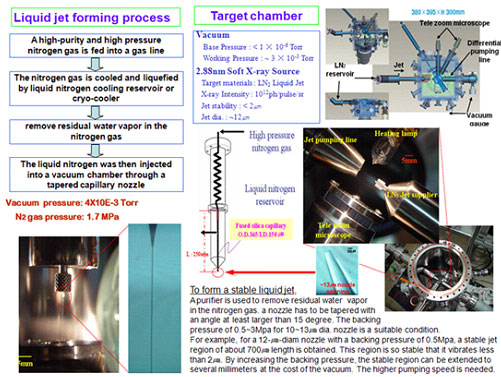|
2. Result
A cryogenic liquid jet system has been developed as two different types. One has a simple cooling system by using LN2for nitrogen gas only to generate a 2.88nm radiation. Another one is able to control any cooling temperature by using LHe for various gas applications to generate a hard x-ray, 13.5nm EUV radiation and ions from the plasma for acceleration etc..

In the case of the liquid nitrogen jet target, the radiation characteristics such as absolute intensity, spectra, and angular distribution have been investigated for different laser pulse durations pico-second and femto-second pulses and laser energies. The comparison of conversion efficiencies between pico-second 120 ps full width at half maximum FWHM and femto-second 40?500 fs FWHM lasers indicates that the pico-second laser would provide better conversion efficiency, which is 1.6% at 2X1013 W/cm2. and also to improve the x-ray intensity using the pico-second laser, the pre-pulse effect has been investigated. in terms of a pre-pulse and main pulse energy, and the delay between two pulses has been carried out.

3. Future plan
- Development of liquid sheet jet for ion acceleration & surface harmonic generation.
- Development of liquid Sn metal jet for EUV radiation generation.
- Coherent x-ray source for Interference Lithography using HHG.
- Hard x-ray generation using collision of e-beam & fs laser.
4. References
- B. Kim, J Kim, B. Ahn, D. Lee, D. Kim, Appl. Phys. Lett. 88, 141501 (2006).
- VMT, POSTECH. Patent 2005-0088459
- J. Son, M. Cho, D. Kim, B. Ahn and J. Kim, Appl. Phys. Lett. 90, 261502 (2007)
- P. A. C. Jansson, U. Vogt, H. M. Hertz, Rev. Sci. Instrum. 76, 043503 (2005)
- Kyong Woo Kim, Phys. Med. Biol. 51 (2006) N99-N107
|

